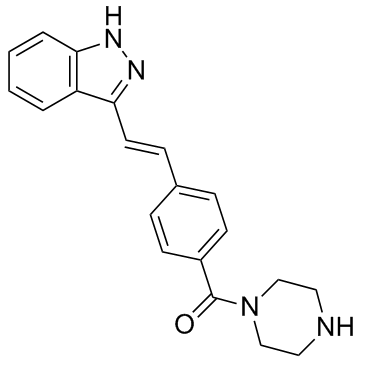KW-2449

KW-2449 structure
|
Common Name | KW-2449 | ||
|---|---|---|---|---|
| CAS Number | 1000669-72-6 | Molecular Weight | 332.399 | |
| Density | 1.3±0.1 g/cm3 | Boiling Point | 604.1±55.0 °C at 760 mmHg | |
| Molecular Formula | C20H20N4O | Melting Point | N/A | |
| MSDS | N/A | Flash Point | 319.1±31.5 °C | |
Use of KW-2449KW-2449 is a multi-targeted kinase inhibitor of FLT3, ABL, ABLT315I and Aurora kinase with IC50s of 6.6, 14, 4 and 48 nM, respectively. |
| Name | [4-[(E)-2-(1H-indazol-3-yl)ethenyl]phenyl]-piperazin-1-ylmethanone |
|---|---|
| Synonym | More Synonyms |
| Description | KW-2449 is a multi-targeted kinase inhibitor of FLT3, ABL, ABLT315I and Aurora kinase with IC50s of 6.6, 14, 4 and 48 nM, respectively. |
|---|---|
| Related Catalog | |
| Target |
Abl:4 nM (IC50) ABL-T315I:14 nM (IC50) FGFR1:36 nM (IC50) Aurora A:48 nM (IC50) FLT3/D835Y:1 nM (IC50) FLT3:6.6 nM (IC50) JAK2:150 nM (IC50) SRC:400 nM (IC50) PDFGRα:1700 nM (IC50) |
| In Vitro | KW-2449 shows growth inhibitory activities against FLT3/ITD-, FLT3/D835Y-, and wt-FLT3/FL-expressing 32D cells, MOLM-13 and MV4;11 with GI50 values of 0.024, 0.046, 0.014, 0.024, and 0.011 μM, respectively. KW-2449 suppresses the phosphorylations of FLT3 (P-FLT3) and its downstream molecule phospho-STAT5 (P-STAT5) in MOLM-13 cells in a dose-dependent manner. KW-2449 increases the percentage of cells in the G1 phase of the cell cycle and reciprocally reduced the percentage of cells in the S phase, resulting in the increase of apoptotic cell population[1]. |
| In Vivo | Oral administration of KW-2449 shows dose-dependent and significant tumor growth inhibition in FLT3-mutated xenograft model with minimum bone marrow suppression. In FLT3 wild-type human leukemia, it induces the reduction of phosphorylated histone H3, G2/M arrest, and apoptosis. In imatinib-resistant leukemia, KW-2449 contributes to release of the resistance by the simultaneous down-regulation of BCR/ABL and Aurora kinases. Furthermore, the antiproliferative activity of KW-2449 is confirmed in primary samples from AML and imatinib-resistant patients. The inhibitory activity of KW-2449 is not affected by the presence of human plasma protein, such as α1-acid glycoprotein[1]. |
| Cell Assay | Cell viability is determined by the sodium 3′-[1-(phenylaminocarbonyl)-3, 4-tetrazolium]-bis (4-methoxy-6-nitro) benzene sulfonic acid hydrate assay after incubation with or without KW-2449 for 72 hours at 37°C. The number of viable cells is determined using the Cell Proliferation Kit II[1]. |
| Animal Admin | Mice: SCID mice are subcutaneously inoculated with MOLM-13 cells. Five days after inoculation, tumor volume is measured using the Antitumor test system II. The 25 mice with tumors ranging from 90 to 130 mm3 are selected and randomized using the Antitumor test system II. From the day of randomization, vehicle (0.5 wt/vol% MC400) or KW-2449 (2.5, 5.0, 10, and 20 mg/kg) is orally administered to mice twice a day for 14 days. Tumor volume is measured twice a week during the treatment[1]. |
| References |
| Density | 1.3±0.1 g/cm3 |
|---|---|
| Boiling Point | 604.1±55.0 °C at 760 mmHg |
| Molecular Formula | C20H20N4O |
| Molecular Weight | 332.399 |
| Flash Point | 319.1±31.5 °C |
| Exact Mass | 332.163696 |
| PSA | 61.02000 |
| LogP | 2.07 |
| Vapour Pressure | 0.0±1.7 mmHg at 25°C |
| Index of Refraction | 1.723 |
| {4-[(E)-2-(1H-Indazol-3-yl)vinyl]phenyl}(1-piperazinyl)methanone |
| cc-533 |
| S2158_Selleck |
| Methanone, [4-[(E)-2-(1H-indazol-3-yl)ethenyl]phenyl]-1-piperazinyl- |
| KW 2449 |
| KW-2449 |
| KW2449 |